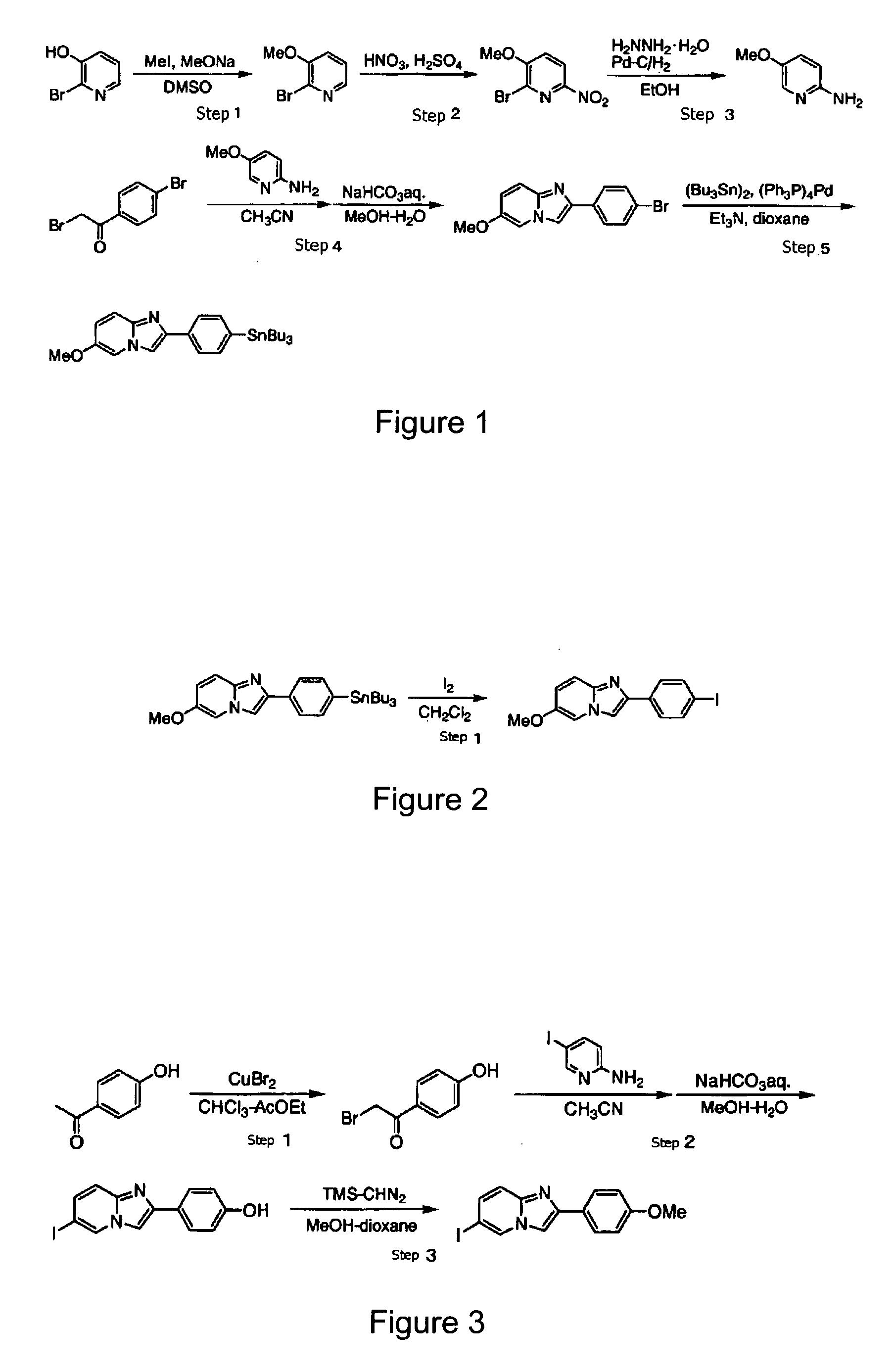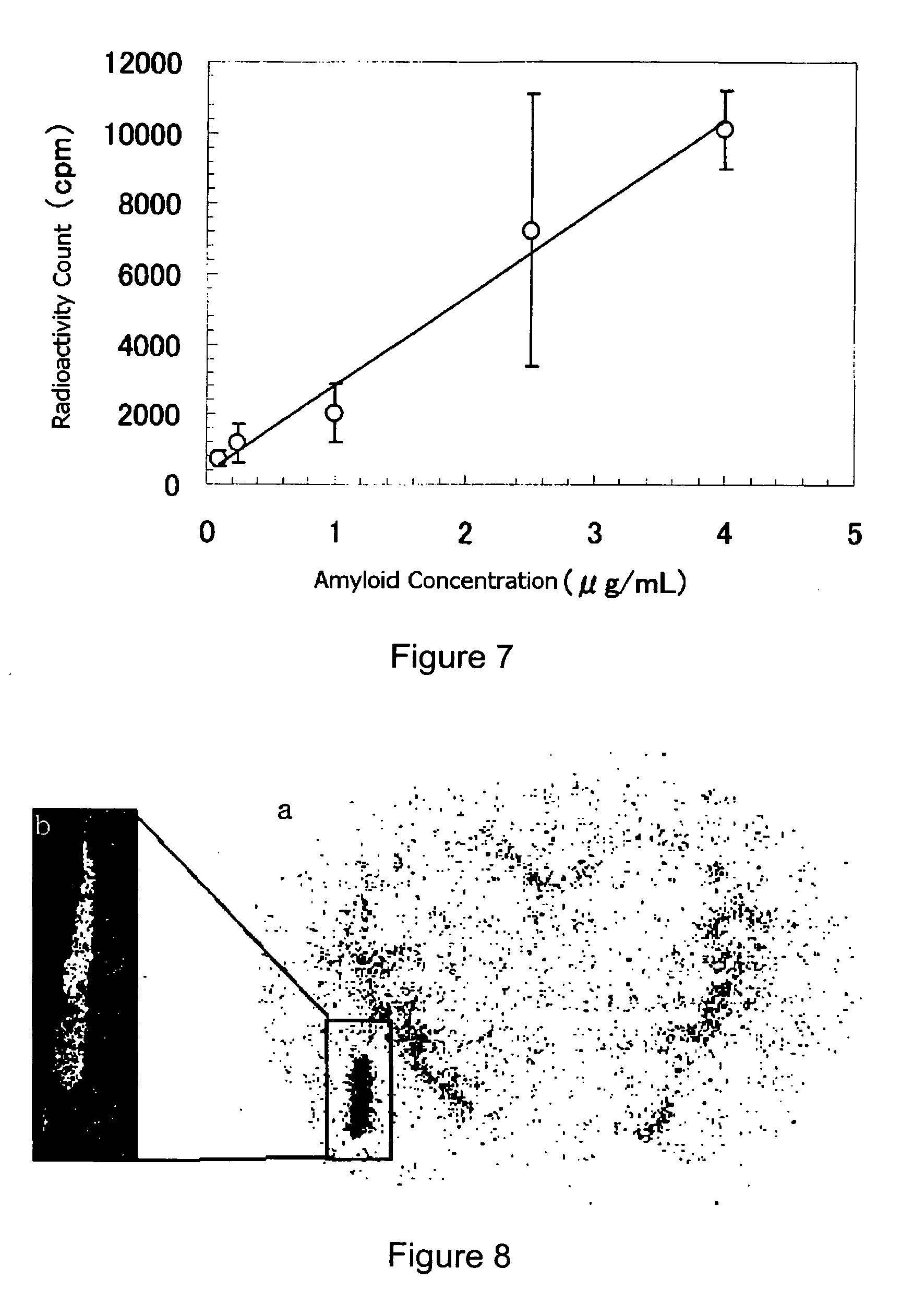Novel compound with affinity for amyloid
a technology of amyloid and compound, applied in the field of amyloid compound for diagnosis of cerebral degenerative disease, can solve the problems of low diagnostic sensitivity based on such evaluations of cognitive functions, social problems, and inability to infuse inborn cognitive functions into diagnostic results
- Summary
- Abstract
- Description
- Claims
- Application Information
AI Technical Summary
Benefits of technology
Problems solved by technology
Method used
Image
Examples
example 1
Synthesis of 2-(4′-tributylstannylphenyl)-6-methoxyimidazo[1,2-a]pyridine
[0069]100.0 g (corresponding to 0.575 mol) of 2-bromo-3-hydroxypyridine was dissolved in 310 mL of dimethylsulfoxide, and 575 mL (corresponding to 0.575 mol) of a 1 mol / L sodium methoxide-methanol solution was added thereto. Then, the reaction solution was heated to 90° C. to distill off methanol. After the reaction solution was cooled down to 10° C. or lower, 93.9 g (corresponding to 0.662 mol) of methyl iodide was added, and then stirred at room temperature for 20.5 hours. After the completion of the reaction, the reaction solution was poured into ice water and extracted twice with chloroform. The combined chloroform layer was washed with a 1 mol / L sodium hydroxide solution, washed twice with a saturated sodium chloride solution, and dried over anhydrous sodium sulfate. After the solvent was distilled off under reduced pressure, 65.4 g (corresponding to 0.348 mol) of 2-bromo-3-methoxypyridine was obtained (FI...
example 2
Synthesis of [123I]-2-(4′-iodophenyl)-6-methoxyimidazo[1,2-a]pyridine
[0078]To 75 μL of a solution of 2-(4′-tributylstannylphenyl)-6-methoxyimidazo[1,2-a]pyridine in methanol (concentration: 1 mg / mL), 100 μL of 1 mol / L hydrochloric acid, 10 μL of 1 mmol / L sodium iodide, [123I]sodium iodide solution of 160 MBq (80 μL in volume) and 20 μL of 10% (w / v) hydrogen peroxide were added. After the mixed solution was left to stand at 50° C. for 10 minutes, the solution was subjected to HPLC under the following conditions, to obtain a fraction of [123I]-2-(4′-iodophenyl)-6-methoxyimidazo[1,2-a]pyridine.
[0079]HPLC conditions:
[0080]Column: Phenomenex Luna C18 (trade name; manufactured by Phenomenex Co.; size: 4.6×150 mm)
[0081]Mobile phase: 0.1% trifluoroacetic acid / acetonitrile=20 / 80 to 0 / 100 (17 minutes, linear gradient)
[0082]Flow rate: 1.0 mL / min.
[0083]Detector: Ultraviolet visible absorptiometer (Detection wavelength: 282 nm) and radioactivity counter (manufactured by raytest: type STEFFI)
[008...
example 3
Synthesis of [125I]-2-(4′-iodophenyl)-6-methoxyimidazo[1,2-a]pyridine
[0089]To 75 μL of a solution of 2-(4′-tributylstannylphenyl)-6-methoxyimidazo[1,2-a]pyridine in methanol (concentration: 1 mg / mL), 100 μL of 1 mol / L hydrochloric acid, 10 μL of 1 mmol / L sodium iodide, [125I]sodium iodide solution of 32 MBq (20 μL in volume) and 20 μL of 10% (w / v) hydrogen peroxide were added. After the mixed solution was left to stand at 50° C. for 10 minutes, the solution was subjected to HPLC under the same conditions as in Example 2, to obtain a fraction of [125I]-2-(4′-iodophenyl)-6-methoxyimidazo[1,2-a]pyridine.
[0090]10 ml of water was added to the fraction. The resulting solution was passed through a reversed phase column (trade name: Sep-Pak (registered trademark) Light C8 Cartridges manufactured by Waters: the packed amount of the packing agent: 130 mg) so that the column adsorbs and collects [125I]-2-(4′-iodophenyl)-6-methoxyimidazo[1,2-a]pyridine. The column was rinsed with 1 mL of water,...
PUM
| Property | Measurement | Unit |
|---|---|---|
| temperature | aaaaa | aaaaa |
| weight | aaaaa | aaaaa |
| temperature | aaaaa | aaaaa |
Abstract
Description
Claims
Application Information
 Login to View More
Login to View More - R&D
- Intellectual Property
- Life Sciences
- Materials
- Tech Scout
- Unparalleled Data Quality
- Higher Quality Content
- 60% Fewer Hallucinations
Browse by: Latest US Patents, China's latest patents, Technical Efficacy Thesaurus, Application Domain, Technology Topic, Popular Technical Reports.
© 2025 PatSnap. All rights reserved.Legal|Privacy policy|Modern Slavery Act Transparency Statement|Sitemap|About US| Contact US: help@patsnap.com



